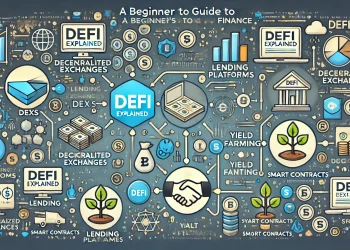The cryptocurrency market is known for its extreme volatility, with prices capable of soaring to new highs or plunging to record lows in a matter of days. For investors, understanding the cycles of bull and bear markets is crucial to navigating these price swings and making informed decisions. These market cycles are an inherent part of any financial market, and the crypto market is no exception. In this comprehensive guide, we’ll break down the dynamics of bull and bear markets, their characteristics, and how investors can strategize during each phase.
Table of Contents
- What Are Crypto Market Cycles?
- What is a Bull Market?
- 2.1 Characteristics of a Bull Market
- 2.2 Factors that Trigger a Bull Market
- What is a Bear Market?
- 3.1 Characteristics of a Bear Market
- 3.2 Factors that Trigger a Bear Market
- Phases of a Crypto Market Cycle
- 4.1 Accumulation Phase
- 4.2 Run-up/Bull Phase
- 4.3 Distribution Phase
- 4.4 Decline/Bear Phase
- Psychological Impacts of Bull and Bear Markets
- How to Identify Bull and Bear Market Trends
- Historical Bull Markets in Cryptocurrency
- Historical Bear Markets in Cryptocurrency
- Investment Strategies for Bull Markets
- Investment Strategies for Bear Markets
- The Role of Market Sentiment
- How to Hedge Risks in Crypto Markets
- The Impact of External Factors on Market Cycles
- How to Stay Informed During Market Cycles
- Common Misconceptions About Bull and Bear Markets
- FAQs About Crypto Market Cycles
1. What Are Crypto Market Cycles?
Crypto market cycles refer to the natural ebb and flow of market prices over time, characterized by periods of growth (bull markets) and decline (bear markets). These cycles are influenced by a range of factors, including investor sentiment, technological developments, regulatory changes, and broader economic conditions. Unlike traditional markets, crypto market cycles tend to be shorter and more volatile, driven in part by the speculative nature of digital assets.
2. What is a Bull Market?
A bull market is a period of rising prices, typically accompanied by increased investor confidence and optimism about the future. In a bull market, demand for cryptocurrencies outpaces supply, leading to upward price momentum. Bull markets are often marked by widespread media attention, institutional interest, and new investors entering the market.
2.1 Characteristics of a Bull Market
- Upward Price Trends: Prices of most cryptocurrencies rise consistently over a period of weeks, months, or even years.
- Increased Trading Volume: There is a surge in buying activity as more investors look to capitalize on rising prices.
- Positive Sentiment: Optimism dominates investor sentiment, leading to more people entering the market.
- New All-Time Highs: Cryptocurrencies frequently hit new all-time highs, generating excitement and attracting even more investors.
- Speculative FOMO (Fear of Missing Out): As prices rise, fear of missing out prompts more investors to buy, fueling further gains.
2.2 Factors that Trigger a Bull Market
- Technological Innovations: Breakthroughs such as the launch of a new blockchain platform or significant upgrades can boost investor confidence.
- Institutional Adoption: When large corporations or institutional investors announce support for cryptocurrencies, it can trigger a bull market.
- Positive Regulation: Regulatory clarity or favorable government policies can spur market growth.
- Macroeconomic Factors: Low-interest rates, quantitative easing, and other favorable macroeconomic conditions can drive investors towards riskier assets like cryptocurrencies.
3. What is a Bear Market?
A bear market is a prolonged period of falling prices, usually accompanied by negative sentiment and reduced trading activity. In a bear market, the supply of cryptocurrencies exceeds demand, causing prices to decline. Bear markets can be triggered by a variety of factors, including regulatory crackdowns, security breaches, or broader economic downturns.
3.1 Characteristics of a Bear Market
- Downward Price Trends: Cryptocurrencies experience sustained price declines, often losing 20% or more of their value.
- Decreased Trading Volume: As prices fall, trading activity slows down, with fewer investors willing to buy into the market.
- Pessimism and Fear: Investor sentiment shifts to fear, uncertainty, and doubt (FUD), leading to panic selling.
- Capitulation: Investors who held through the early stages of the downturn eventually “capitulate” and sell their assets at a loss.
- Lengthy Recovery Period: Bear markets can last months or even years, with prices taking a long time to recover.
3.2 Factors that Trigger a Bear Market
- Negative News or Regulation: Announcements of regulatory crackdowns or unfavorable news can trigger panic selling.
- Hacks and Security Breaches: Major security incidents, such as the hacking of a prominent exchange, can undermine confidence in the market.
- Macroeconomic Factors: Recession fears, rising interest rates, or a general flight to safety can lead to a bear market.
- Market Corrections: After a prolonged bull market, prices often correct as speculative bubbles burst, leading to a bear phase.
4. Phases of a Crypto Market Cycle
Understanding the distinct phases of a market cycle can help investors better predict when to enter or exit the market.
4.1 Accumulation Phase
This phase occurs at the end of a bear market when prices stabilize, and savvy investors begin accumulating assets at lower prices. Sentiment is generally neutral, and trading volumes are low.
4.2 Run-up/Bull Phase
After accumulation, prices begin to rise as demand increases. This phase is characterized by optimism, media coverage, and a sharp increase in trading volumes. The market enters a bull cycle, and prices start to skyrocket.
4.3 Distribution Phase
In the distribution phase, early investors begin taking profits as prices reach their peak. While some new investors continue to buy, market enthusiasm begins to wane. Trading volumes may remain high, but the price movement slows or becomes volatile.
4.4 Decline/Bear Phase
The market enters a bear cycle as prices fall due to declining demand and panic selling. Investor sentiment turns negative, and prices continue to drop as the cycle reaches its low point.
5. Psychological Impacts of Bull and Bear Markets
Market cycles can have a profound impact on investor psychology. During a bull market, optimism and excitement can drive irrational exuberance, leading investors to take on more risk than they should. In contrast, bear markets often bring fear and panic, causing investors to sell at a loss, even if they believe in the long-term value of their assets. Understanding these psychological effects can help investors make more rational decisions and avoid emotional pitfalls.
6. How to Identify Bull and Bear Market Trends
Recognizing whether the market is in a bull or bear phase is crucial for timing investments effectively.
- Bull Market Indicators: Rising prices, increasing volume, and positive sentiment in the media are strong indicators of a bull market. Look for new all-time highs and surging interest from institutional investors.
- Bear Market Indicators: Prolonged price declines, decreasing trading volume, and widespread pessimism are key signs of a bear market. Major news events like regulatory crackdowns or exchange hacks can also trigger a bear phase.
Technical analysis tools, such as moving averages, the Relative Strength Index (RSI), and Fibonacci retracements, can help identify market trends and potential reversal points.
7. Historical Bull Markets in Cryptocurrency
- 2017 Bull Run: Bitcoin surged from $1,000 in January to nearly $20,000 in December, fueled by widespread media coverage, the rise of ICOs, and retail investor enthusiasm.
- 2020-2021 Bull Run: Bitcoin and Ethereum reached new all-time highs, with Bitcoin exceeding $60,000. This bull market was driven by institutional interest, the rise of decentralized finance (DeFi), and increasing adoption of cryptocurrencies as an asset class.
8. Historical Bear Markets in Cryptocurrency
- 2018 Crypto Winter: After the 2017 bull run, the market entered a brutal bear phase in 2018. Bitcoin’s price dropped from nearly $20,000 to below $4,000, and many altcoins lost over 90% of their value. The ICO bubble burst, leading to widespread losses.
- 2022 Bear Market: Triggered by rising inflation, interest rate hikes, and a broader sell-off in risk assets, the crypto market experienced a significant downturn in 2022. Bitcoin’s price dropped by over 60%, and many altcoins suffered similar declines.
9. Investment Strategies for Bull Markets
During a bull market, the primary goal is to maximize gains while managing risk:
- HODLing: Holding onto assets for the long term can be a highly effective strategy in a bull market, allowing investors to capture large price gains over time.
- Buying on Dips: Taking advantage of temporary price corrections can be a way to accumulate more assets during a bull phase.
- Trailing Stop-Loss Orders: Setting trailing stop-loss orders can help lock in gains by automatically selling if the price drops by a predetermined percentage.
10. Investment Strategies for Bear Markets
In a bear market, preserving capital and minimizing losses become the top priorities:
- Dollar-Cost Averaging (DCA): This strategy involves regularly purchasing a fixed amount of cryptocurrency, regardless of price, allowing you to average out the cost of your investments over time.
- Stablecoins: Converting assets into stablecoins can help protect against volatility while waiting for the market to recover.
- Short Selling: Advanced traders may choose to short-sell cryptocurrencies, betting on further price declines.
11. The Role of Market Sentiment
Market sentiment, or the overall attitude of investors, plays a crucial role in driving market cycles. Positive sentiment during a bull market can lead to price overextension, while negative sentiment during a bear market can cause prices to drop further than fundamentals justify. Tools like the Fear and Greed Index can help gauge market sentiment and provide insights into potential turning points.
12. How to Hedge Risks in Crypto Markets
Hedging strategies can help protect against the downside during bear markets or price corrections:
- Diversification: Spread your investments across different cryptocurrencies and asset classes to reduce risk.
- Futures and Options: Advanced traders can use futures and options contracts to hedge against potential price movements.
- Stop-Loss Orders: Setting stop-loss orders can automatically sell your assets if prices fall below a certain threshold, limiting losses.
13. The Impact of External Factors on Market Cycles
Several external factors influence crypto market cycles, including:
- Global Economic Conditions: Economic factors such as inflation, interest rates, and economic recessions can affect investor appetite for risk assets like cryptocurrencies.
- Regulation: Announcements of new regulations or government policies can trigger either bull or bear markets.
- Technological Advancements: Innovations in blockchain technology can drive market growth, while setbacks can lead to declines.
14. How to Stay Informed During Market Cycles
Staying informed about the latest news and developments is essential for navigating crypto market cycles. Following reputable crypto news outlets, subscribing to market analysis reports, and engaging with online communities can provide valuable insights. Additionally, using technical analysis tools can help identify trends and potential turning points.
15. Common Misconceptions About Bull and Bear Markets
- Misconception 1: Bull markets last forever. In reality, every bull market is followed by a bear market.
- Misconception 2: Bear markets are bad for investors. While bear markets are challenging, they also present opportunities for accumulating assets at lower prices.
- Misconception 3: All cryptocurrencies perform the same in a bull or bear market. In reality, different cryptocurrencies can react differently depending on market conditions and individual developments.
16. FAQs About Crypto Market Cycles
Q1: How long do bull and bear markets typically last? Bull and bear markets can last anywhere from a few weeks to several years, depending on the underlying market conditions and external factors.
Q2: Can you make money in a bear market? Yes, investors can make money in bear markets through strategies like short selling, dollar-cost averaging, or by investing in stablecoins.
Q3: What triggers a market cycle reversal? Market reversals can be triggered by changes in investor sentiment, regulatory developments, macroeconomic factors, or technological advancements.
Q4: Should I sell during a bear market? It depends on your investment strategy. Some investors choose to hold through bear markets, while others may sell to preserve capital and buy back in at lower prices.
Q5: How can I tell if a bull market is ending? Indicators of a bull market ending include decreasing trading volume, increased volatility, and negative news or regulatory developments.
Q6: Are market cycles the same in traditional financial markets? While the general principles of market cycles apply to both traditional and crypto markets, the crypto market tends to experience more rapid and extreme cycles due to its relatively young and volatile nature.
Conclusion
Understanding crypto market cycles—particularly the dynamics of bull and bear markets—is essential for making informed investment decisions. Each phase of the market cycle presents unique opportunities and challenges, and recognizing the signs of a cycle shift can help you maximize profits and minimize losses. Whether you’re navigating a bull market’s euphoria or bracing for the challenges of a bear market, adopting a sound strategy based on thorough research and risk management is the key to long-term success in the cryptocurrency space.
=====================















